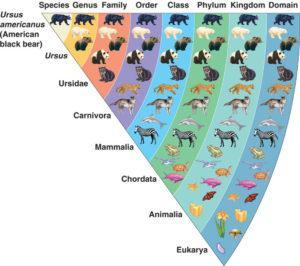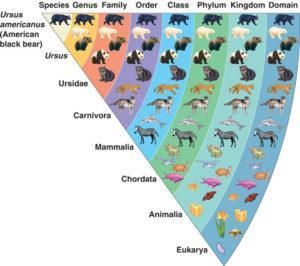When people object to evolution they typically do so in a handful of ways, like the classic " why are there still monkeys?" An argument so common that the great " take that Darwin" twitter account always manages to find a dozen or so examples every day. Another is that any given example of evolution simply represents a change within "kinds". Birds stay birds, and bats remain bats.
A reader recently asked for the evidence for evolution. Alas, they were unconvinced by what I wrote. Their response essentially revolved around this classic argument. They claimed that all the examples of evolution I gave simply represented some sort of intra-kind variation. So today I'm breaking down their objections and, in the process, tackling some deeper evolution denier memes.
Staying within kinds
When I say that Don - the reader in questions - response revolved around the "kinds" argument, this was not an exaggeration. Their reply email consisted of three paragraphs. Two and half of these were reiterating the argument that the birds remained birds and so forth. That's why the quote below is so long, it represents almost the entire email.
Plus each of the creatures remain mosquitoes, peppered moths and bacteria. . . . Again however they are still birds. If you were showing some type of change in which say the bird could be seen as beginning a change into a dinosaur then one would need to give the matter serious consideration.
As far as I can see the E. coli are still E. coli however. Please correct me if I am wrong. The mutations are causing certain changes in the E. coli but E. coli they remain it seems to me.
Of course, this is not a new argument invented by Don. It's been propagated by all the big creationist organisations. Answers in Genesis is even in the process of trying to figure out which species belong to which kinds, which has led to some rather fierce debates over where mosaic species like Homo naledi should fit.
It was perhaps most famously put forward by the one-and-only Ray Comfort. He argued that we should see shifts between kinds if evolution were true. His example of what such a change would look like? The incredible crocoduck.
Nevertheless, Don does an excellent job summarising the main argument. So let's deal with it. If evolution were true, should see a bird changing into a non-bird?
Kinds - secretly evidence for evolution
Sorry to keep you on tenterhooks for an entire sub-heading, but the answer is no. In fact, this within-group change is exactly what you'd expect an evolving species to look like. And it all comes from how we define groups. Allow me to explain.
When we label an animal we do so hierarchically. Imagine a pool of all animals that we begin dividing into boxes. Each box then gets further subdivided based on shared features within that box. Crucially, each new box exists within the previous tier. Mammals contain carnivores. Carnivores contain bears. But crucially, a bear is still a mammal.

Interestingly, this means our description of bears recapitulates their evolution to some degree. At some point, carnivores diverged from other mammals. And then bears diverged from other carnivores 1
In other words, as things evolve they gain new labels, but never lose the old ones 2. This stems from the gradual nature of evolution. You don't get these massive sideways leaps into a new clade. As such, the fact you keep getting this "birds staying birds" is actually evidence for evolution. And the infamous crocoduck would actually be evidence against it.
Defining kinds
So, the main problem with this argument is that it offers up a false criticism. An argument that ostensibly sounds convincing, but doesn't offer a real counterpoint to evolutionary claims. Unfortunately, it isn't the only flaw in the argument.
The other issue stems from how the groups in question are defined. Note again this nice, succinct summary from Don:
Plus each of the creatures remain mosquitoes, peppered moths and bacteria. . . . Again however they are still birds.
Here, we're critiquing the amount of documented change. However, each of these represents a different taxonomic tier. Let's return to our bear chart.

Peppered moths are a species. Mosquitos are a family. Birds are a class. Bacteria are a domain. Each represents a different tier and thus would tolerate a differing degree of change whilst still being considered change within a kind. A peppered moth could change so much it is no longer a peppered moth (even becoming sort of weird crocoduck hybrid) and still not have changed enough for it to shift family.
In other words, how much change can be tolerated within one of Don's "kinds" is variable because the definition of a kind is variable. Goalposts can keep moving just enough to ensure no shift can be counted as proper evolution.
There are some creationists who recognise this flaw in the argument and are trying to come up with a more rigorous definition of a kind. The resulting pursuit is baraminology and is widely propagated by Answers in Genesis, who have a whole series of articles trying to define various kinds. However, these efforts undermine the validity of this concept more than justify it. For when they produce results the creationists in question don't like, goalposts are moved again; reinforcing the subjective nature of kinds as "whatever it takes to disprove evolution."
Conclusion
The "birds are still birds" argument falls down because, based on evolutionary principles, birds should remain birds. As they gradually change they should become birds+. But they would still be labelled birds, because that's how we describe species. Just like how humans have changed compared to apes, but are still technically apes. And apes are primates, and so forth.
Even if we would expect to see dramatic changes that went beyond taxonomic boundary, this argument also varies which sort of boundaries must be crossed to vindicate evolution. It's a moving goalpost that always changes just enough to ensure no evidence is sufficient.
Caveats
See them little numbers throughout the post. The refer to bits here. Because I'm thorough like that.
- There are some cases where the labels don't accurately align with a group's evolutionary history. This is because they were developed before evolution was fully understood. This resulted in so-called polyphyletic clades that scientists are working to fix.
- The current way of grouping species was developed by a creationist. As such, it's not great at dealing with evolution. There has been some debate at how to fix this when a species changes. One solution may involve a species changing low-tier labels, like genus or species. So it may be the case that in some circumstances a species does lose some minor labels. Although this doesn't really change the point I'm making.

